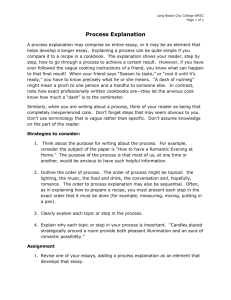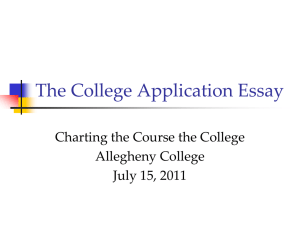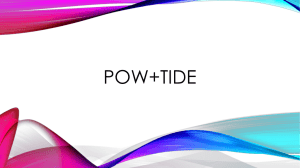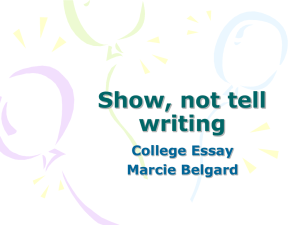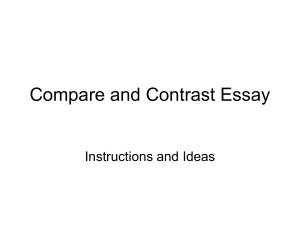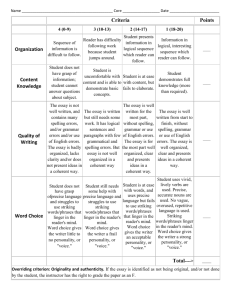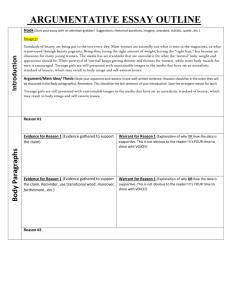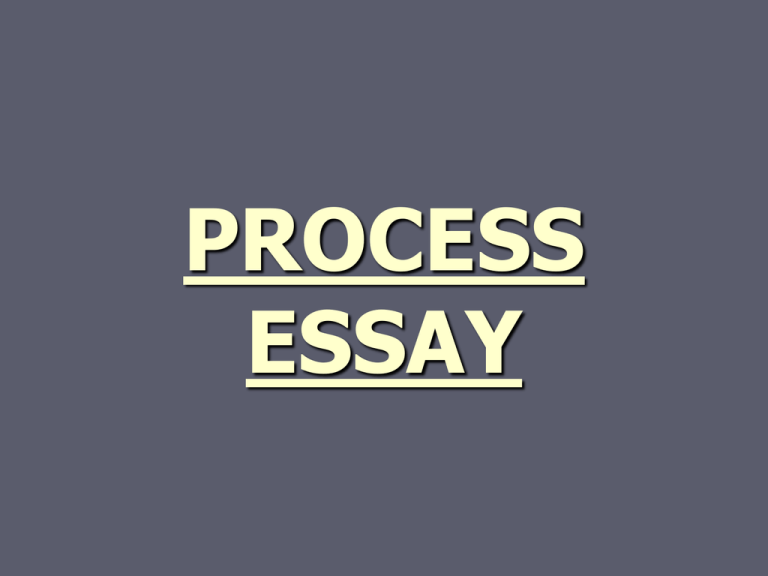
PROCESS
ESSAY
YOU, YOU, YOU
*This is the only essay in which you are directly
addressing the reader, so get all the you’s out
of your system now.
you, you, you, you, you
“you are”
NOT “you’re”
“your” is allowed
2
INTRODUCTION
SCENARIO
**SCENARIO:
Create a context for this process
What situation would dictate the reader
needing to know how to perform this task?
Why should the reader know how to do this
activity?
purpose: answer the “so what?!” factor
3
INTRODUCTION
4
OVERVIEW OF THE ENTIRE PROCESS
*OVERVIEW:
Now that you have gained our interest and
created a need by virtue of the scenario, now tell
us exactly what we are in for—
How many steps?
What is the difficulty level?
How long should it take?
Divide into recognizable parts
Describe the result (sense details; “After
following my easy, 5-step process, you will
have created a warm, nutritious meal.”)
INTRODUCTION
5
**PURPOSE STATEMENT:
**PURPOSE STATEMENT:
like a thesis statement
what will concern; why readers should do
Combine “overview” with your purpose to get a
thesis statement:
In six easy steps that should take you ten
minutes, you can create a fast yet nutritious
meal for yourself.
purpose: answer the “so what?!” factor
INTRODUCTION
6
EXAMPLES
*EXAMPLES OF CREATING A SCENARIO &
INTRODUCING THE TOPIC:
1) Have you ever been driving home late at night on a
dark, deserted road and…..
2) Girls, are you tired of being seen as only sex
objects? OR Feminism is dead, and women are now,
more than ever, seen as simply sex objects. Well, girls,
if that is how they are going to treat us, then we should
use it to our advantage. One of the best instances to
use, as Mama always said, “the gifts th’ Good Lord gave
ya” is when you are pulled over by a police officer for a
moving violation. I have three simple steps for getting
out of a speeding ticket.
BODY’s 1st sentence: The first step in changing a tire is
to….
7
BODY
*STEP-BY-STEP:
assume nothing
presume your audience=NOVICES
reader knows nothing about your topic
reader has never performed this task before
DIRECTIVE (how-to, technical writing)
vs/
INFORMATIVE (close to narrative)
8
BODY
*THIS IS AN ESSAY, SO…
*NO LISTS*
*NO RECIPES (keep in essay format)
*do not forget the ARTICLES (a, an, the)
*do not forget the INTRODUCTION &
CONCLUSION paragraphs
9
BODY
*COHERENCE:
*CHRONOLOGICAL ORDER
*TRANSITIONS
first, then, next,
* “First, get the….” AND “Next, use the…”
(vs.) “The first step is to…” AND “The next
task involves…”
*SUBORDINATING CONJUNCTIONS
after, before
10
BODY
*DETAILS:
* STEP #1: gather all materials 1st (items
should NOT just magically appear in the middle
of the process)
* “HOW EXACTLY” (don’t skip over steps; the
devil is in the details)
use DESCRIPTIVE DETAILS
since this is not necessarily a 5-paragraph
essay, group steps into related
PHASES/STAGES
11
BODY
*FLAVOR:
make PERSONAL SUGGESTIONS or
PREFERENCES (if no specific brand/flavor is
required) (i.e., amount of salt)
make TIPS (better use a pot holder)
give SPECIFIC INSTANCE if “it depends”
briefly explain the REASON for a step if it is not
obvious (do this to prevent a mess)
12
BODY
*GRAMMAR:
spell “INGREDIENTS” correctly
no “THINGS” (steps, tasks) (items, utensils)
350 degrees (not the symbol for degrees)
medium-sized pan (hyphen, -ed)
“THEN”=not a conjunction (use “, and then”)
COMMAS (“Introductory subordinate clause,”)
(between two I.C. joined by a C.C.)
COLONS (“First, gather the following
ingredients: milk, sugar, and flour.”)
13
CONCLUSION
*CONSIDER THE PROCESS AS A WHOLE:
repeat/reference the PURPOSE of your process
(why did you tell us how to do this)
describe the FINISHED PRODUCT (smells,
taste, sight, feel, sound)
total TIME of the process
CLINCHER SENTENCE
14
LITMUS TEST
*** CAN THE READER DO IT? ***
15
TOPICS
*HOW TO:
SCHOOL:
Take Notes
Study
Prepare for a Test
Prepare for a Job Interview
Create a RÉSUMÉ
Deal with Stress (in a healthy manner)
Deal with a Death in the Family
16
TOPICS
*HOW TO:
KIDS: brush teeth, tie shoe laces, tie a tie
FOOD: make lasagna, spaghetti, German apple
cake, cheeseburger, grilled cheese, PB&J,
home-made Easter candy, dye Easter eggs, JellO shapes
SPORTS: play football (be specific: block, pass,
punt, tackle); shoot foul shot, jump serve in
volleyball, swim (specific stroke or dive)
17
TOPICS
PAMPER: give yourself a pedicure, make Jane’s
special bubble bath
CAR: change a tire, change brakes, change oil,
change wiper blades, pump gas, drive
standard/manual transmission (stick shift),
buy used car/the perfect car for you
JOB: waitress/server, nurse’s aide, transfer
patient, install carpet, customer service
18
TOPICS
HAIR: wash, perm, color, treat, highlight
CLEAN: wash hair, clothes, car, dog; clean
hamster cage
OTHERS: plan a vacation, plant a garden, ice
fish, follow the traditions of Islamic ablution,
convert to Judaism
19
FINAL HINTS
*REMEMBER, this is an essay and not a recipe,
SO…
essay format, no lists (does NOT look like a
recipe card)
when gathering supplies, write as items in a
series (not as a list, not as a recipe card)
“After doing that step, you will need to gather
the following materials: x, y, and z.” (notice
the colon after “the following”; do not use a
colon after a Linking Verb)
20
PREWRITING
1) LISTS:
3 tasks done at work each time
3 foods you like to make
3 technical/electrical/mechanical skills you
have
3 chores done weekly
21
PREWRITING
2) STEPS:
brainstorm
list every step in the process
list related sense details
22
PREWRITING
3) BEFORE YOU WRITE:
do the process yourself
details are then fresh in your mind & you will
not skip any steps
plus, suggestions make themselves apparent
HOW TO MAKE
MACARONI & CHEESE
STEP
#1
23
24
STEP #2
25
STEP #3
26
STEP #4
27
STEP #5
28
STEP #6
29
STEP #7
30
CONCLUSION
31
OTHER PROCESSES
32
OTHER PROCESSES

